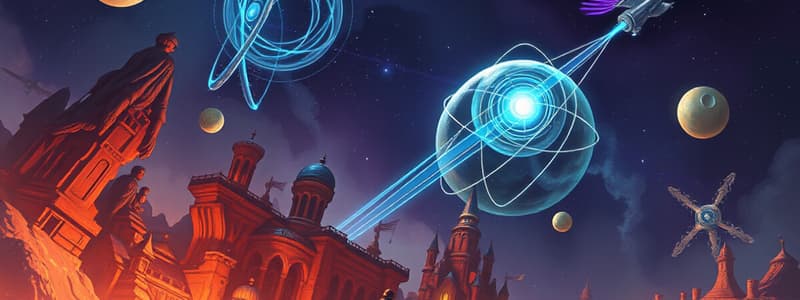Podcast
Questions and Answers
The Greeks made major contributions to __________ and Mathematics.
The Greeks made major contributions to __________ and Mathematics.
Philosophy
The __________ was a significant achievement of the Greeks, known for its architectural grandeur.
The __________ was a significant achievement of the Greeks, known for its architectural grandeur.
Coliseum
The Roman Empire is regarded as the cradle of __________ and governance.
The Roman Empire is regarded as the cradle of __________ and governance.
politics
Romans developed a unique __________ numeral system for counting and record-keeping.
Romans developed a unique __________ numeral system for counting and record-keeping.
China is known for its contributions to the silk trade and the __________ Wall.
China is known for its contributions to the silk trade and the __________ Wall.
The start of the Middle Ages faced challenges due to massive invasions and __________.
The start of the Middle Ages faced challenges due to massive invasions and __________.
The invention of the mechanical __________ press revolutionized record keeping and publishing.
The invention of the mechanical __________ press revolutionized record keeping and publishing.
Experts needed devices to study __________ in order to develop proper medicines during urbanization.
Experts needed devices to study __________ in order to develop proper medicines during urbanization.
Zacharias Janssen developed the first compound ______.
Zacharias Janssen developed the first compound ______.
During the Middle Ages, the invention of the ______ helped navigators observe remote objects.
During the Middle Ages, the invention of the ______ helped navigators observe remote objects.
Iron body armors were created to protect soldiers during ______ combat.
Iron body armors were created to protect soldiers during ______ combat.
The invention of ______ helped solve the problem of heavy body armors restricting movement.
The invention of ______ helped solve the problem of heavy body armors restricting movement.
The booming world ______ during the nineteenth century required efficient goods production.
The booming world ______ during the nineteenth century required efficient goods production.
Louis Pasteur invented ______ to kill harmful bacteria in dairy products.
Louis Pasteur invented ______ to kill harmful bacteria in dairy products.
With increased trade, communication became essential for nations to maintain ______.
With increased trade, communication became essential for nations to maintain ______.
Governments needed a communication system to properly administer their ______.
Governments needed a communication system to properly administer their ______.
The ancient civilization known for the first writing system called ______ is the Sumerians.
The ancient civilization known for the first writing system called ______ is the Sumerians.
The ______ Garden of Babylon is considered one of the seven wonders of the world.
The ______ Garden of Babylon is considered one of the seven wonders of the world.
The ancient Egyptians are well-known for their iconic architectural feats, most notably the ______ of Giza.
The ancient Egyptians are well-known for their iconic architectural feats, most notably the ______ of Giza.
The death mask of ______ is among the most recognized archaeological artifacts from ancient Egypt.
The death mask of ______ is among the most recognized archaeological artifacts from ancient Egypt.
Ancient Egyptians invented the ______ clock, also known as a clepsydra, for timekeeping.
Ancient Egyptians invented the ______ clock, also known as a clepsydra, for timekeeping.
The ancient Egyptians developed a system of writing known as ______.
The ancient Egyptians developed a system of writing known as ______.
Cosmetics were invented by the ______ Egyptians for aesthetic purposes.
Cosmetics were invented by the ______ Egyptians for aesthetic purposes.
Wigs were worn by wealthy Egyptians to protect their shaved heads from the ______ rays of the sun.
Wigs were worn by wealthy Egyptians to protect their shaved heads from the ______ rays of the sun.
The first public typhoon warning was issued by Fr, Federico ______ in 1897.
The first public typhoon warning was issued by Fr, Federico ______ in 1897.
The Manila Observatory was established by ______ who promoted meteorological studies.
The Manila Observatory was established by ______ who promoted meteorological studies.
After the Spanish regime, the Philippines shifted from an agricultural to an ______ economy.
After the Spanish regime, the Philippines shifted from an agricultural to an ______ economy.
The University of the Philippines Los ______ was established for higher education in the sciences.
The University of the Philippines Los ______ was established for higher education in the sciences.
The Science Act of ______ was enacted to improve the state of science and technology in the Philippines.
The Science Act of ______ was enacted to improve the state of science and technology in the Philippines.
The ______ Development Board was created to coordinate the work of science agencies.
The ______ Development Board was created to coordinate the work of science agencies.
The Philippine Atomic Energy Commission (PAEC) was established to explore the use of atomic energy for ______ development.
The Philippine Atomic Energy Commission (PAEC) was established to explore the use of atomic energy for ______ development.
In 1972, the National Grains ______ was created to support the rice and corn industry.
In 1972, the National Grains ______ was created to support the rice and corn industry.
The invention of the telephone by Alexander ______ was crucial for fast communication.
The invention of the telephone by Alexander ______ was crucial for fast communication.
Modern calculators were developed to perform more ______ arithmetic operations.
Modern calculators were developed to perform more ______ arithmetic operations.
During pre-colonial times, early Filipino settlers utilized ______ for recording purposes.
During pre-colonial times, early Filipino settlers utilized ______ for recording purposes.
The Banaue Rice ______ is an example of sophisticated engineering from the pre-colonial era.
The Banaue Rice ______ is an example of sophisticated engineering from the pre-colonial era.
The Spanish regime established formal ______ and scientific institutions in the Philippines.
The Spanish regime established formal ______ and scientific institutions in the Philippines.
Filipinos learned to build boats for coastal ______ and bartering goods.
Filipinos learned to build boats for coastal ______ and bartering goods.
Innovations during the colonial period included advancements in ______ and sanitation.
Innovations during the colonial period included advancements in ______ and sanitation.
The refining and smelting of ______ were notable technological practices among early Filipinos.
The refining and smelting of ______ were notable technological practices among early Filipinos.
Flashcards are hidden until you start studying
Study Notes
Learning Outcomes
- Understand the historical interactions between science, technology, and society.
- Explore the societal and environmental impacts of scientific and technological advancements.
- Analyze historical paradigm shifts and intellectual revolutions.
- Investigate technological developments in the information age.
- Assess the role of science and technology in Philippine nation-building.
- Evaluate government policies on science and technology in the Philippines.
Historical Antecedents in Science and Technology
Science and Technology in Ancient Times
- Ancients prioritized transportation, communication, mass production, security, health, and architecture.
- Sumerians developed cuneiform, the first writing system.
- Babylonians are famous for the Hanging Gardens, one of the Seven Wonders of the World.
- Ancient Egyptians contributed innovations like the water clock, papyrus, ink, and cosmetics, alongside remarkable artifacts such as the Pyramid of Giza and Tutankhamen's death mask.
- Greeks significantly advanced philosophy and mathematics; innovations included the coliseum, Olympics, and alarm clock.
- Romans introduced the codified legal system and outstanding architecture; known for structures like aqueducts and the Roman numeral system.
- China, Asia's oldest civilization, is recognized for silk production, tea, gunpowder, and the Great Wall.
Science and Technology in Middle Ages
- Middle Ages featured invasions and migrations, necessitating advancements in weaponry and navigation.
- The printing press evolved from woodblock printing thanks to Johann Gutenberg, facilitating record-keeping and communication.
- Rapid urbanization led to health challenges, prompting development of the first compound microscope by Zacharias Janssen.
- Navigators benefited from the invention of the telescope during the Age of Exploration.
- Innovations in weaponry, including crossbows and iron body armor, emerged to suit wartime needs, with chainmail providing better mobility.
Science and Technology in Modern Times
- Rapid population growth in the 19th century demanded increased production and efficient transportation.
- Louis Pasteur developed pasteurization to improve food safety, also contributing to vaccination and fermentation methods.
- Alexander Graham Bell invented the telephone, a crucial advancement for communication and administration.
- Modern calculators emerged to meet the demand for quick computations, leading to developments in computing technology.
Science and Technology in the Philippines
Precolonial Science and Technology
- Early Filipinos excelled in fire use, pottery, herbal medicine, and sophisticated agricultural practices like the Banaue Rice Terraces.
- They utilized rudimentary writing, but no extensive literary records exist from this period.
Colonial Science and Technology
- Under Spanish rule, formal education, scientific institutions, and improved agricultural practices were established.
- Jesuits contributed to meteorological studies, founding the Manila Observatory which issued early typhoon warnings.
- Transition from an agricultural to an exporting economy marked the end of Spanish rule, impacted by foreign competition.
American Regime Contributions
- Strong emphasis on education in science and engineering; introduction of science, vocational courses, and public health programs.
- Creation of research institutions such as the University of the Philippines Los Baños and engaging scholarships for further studies.
- World War II disrupted educational and scientific advancements in the Philippines, damaging key infrastructures.
Post-Colonial Science and Technology
- The Science Act of 1958 aimed to revive scientific development, establishing the National Science Development Board (NSDB) and Philippine Atomic Energy Commission (PAEC).
- Agencies were created to modernize industries, including the coconut industry, rice development, and agricultural research for overall national progress.
Studying That Suits You
Use AI to generate personalized quizzes and flashcards to suit your learning preferences.




